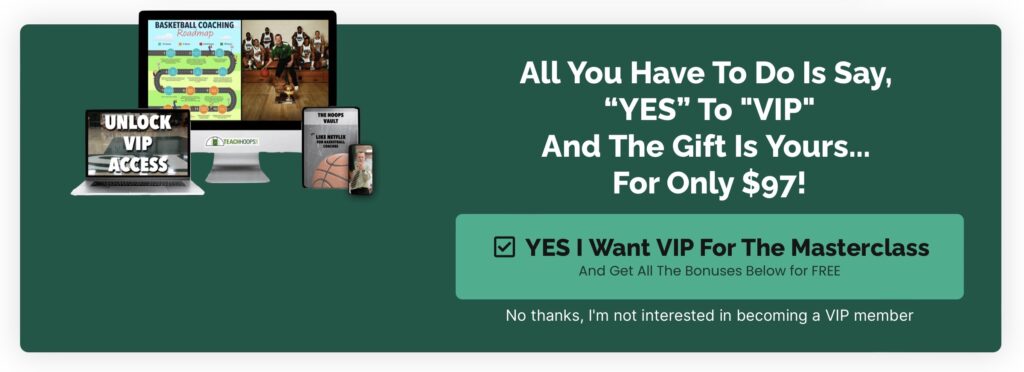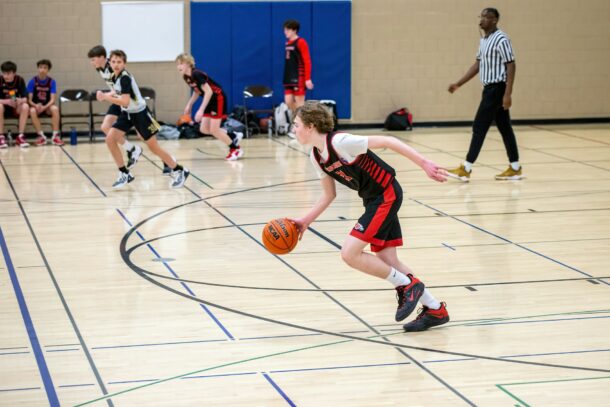Short on players doesn’t mean short on progress. This guide gives you basketball drills for small groups that turn low-number practices into high-impact skill sessions. Whether only two, three, or four athletes show, you’ll have simple, repeatable plans for ball handling, shooting, finishing, and small-sided games that teach real reads and keep every rep purposeful.
Why this happens and how to handle it
Low turnout is normal in youth hoops. Schedules collide, rides fall through, and injuries pop up. The fix is simple: arrive with multiple versions of your plan so you can pivot fast.
- Bring a “full team” plan, a “small group” plan, and a “skills only” plan.
- Over-plan the clock. For a 2-hour slot, prep 2.5 to 3 hours of activities so you never hit dead time.
- Treat low numbers as a chance for high-impact reps and individual coaching.
Your small-group practice menu
Focus on ball handling, shooting form, footwork, finishing, and simple reads. You can also micro-teach team concepts in tight spaces.
3 player basketball drills
- 2-on-1 to 1-on-2
Attack two vs. one, then the defender outlets to trigger a quick 1-on-2 return.
Cues: Wide spacing, one hard paint touch, finish through contact. - Triangle passing with screen action
Corner, wing, top. Pass, follow to set a down screen, catch, and shoot or drive.
Cues: Set feet before catch, screen angle at the defender’s hip. - 3-man pick-and-roll series
Ball handler, screener, spacer. Rep roll, short roll, and slip.
Cues: Set up defender, change pace, hit the pocket pass early. - Closeout and help 2v1 shell
One on the ball, one in gap, one as passer. Rotate after each rep.
Cues: Choppy feet on closeout, high hand, see ball and man. - Shooting circuit
Form shooting, one-dribble pull-ups, spot-up threes, finishing package.
Cues: Hold follow-through, land on balance, finish outside hand off one foot and two.
2 player basketball drills
- 1-on-1 constraints
Start from wing, slot, or post. Limit dribbles or require a paint touch before the shot.
Cues: First step wins, protect the ball, finish on the far side. - Partner passing and shooting
30-second blocks: snap passes, relocation, catch-and-shoot, dribble-handoff into pull-up.
Cues: Hit target hand, show hands early, shoot on the hop. - Screen and slip mini-series
Set, show, and slip when defender jumps the screen.
Cues: Sprint into screen, wide base, slip on contact. - Finishing ladder
Power layups, inside-hand, reverse, floater, euro, pro-hop.
Cues: Eyes on backboard markers, protect with body.
1 player workouts (when it’s just you and an athlete)
- Form shooting tree
Knee/waist/shoulder range, 25 makes each, swish or redo. - Ball-handling lane
Stationary pound series, cross/inside-out, then cone slalom to a finish. - Mikan variations
Standard, reverse, power finishes, no-backboard touch for soft hands. - Chair reads
Use chairs as defenders for straight-line drives and stop-on-two jumpers.
Join the TeachHoops Community

TeachHoops.com offers a unique platform for coaches to share experiences and gain new insights. Learn from others who have navigated similar challenges. It’s an invaluable resource for those looking to:
- Broaden perspectives
- Refine strategies
- Enhance their leadership and motivational skills
Step into Enhanced Coaching
Win the Season: Basketball Masterclass!

Teach a team concept with only three
You can still build “team basketball” with three players.
- Half-court pick-and-roll reads
Ball handler, screener, and spacer. Rep: roll, pop, short roll to dotted line, baseline drift kick.
Progression: Call out a read before each rep to lock in decisions. - Quarter-court offense breakdown
Run only the first action of your motion or continuity. Emphasize spacing and timing.
Small-sided games that scale
- 1v1 to advantage: Winner stays, losers do quick skill reps.
- 2v2 “first to 5 stops”: Defense scores by getting stops. Teaches pride and positioning.
- 3v3 half-court: Call a rule each game (must post touch, paint touch before three, only weak-hand finishes).
Two plug-and-play practice plans
Plan A: 60 minutes, 3 players
- 00:00–05: Dynamic warm-up and ball-handling lane
- 05:00–15: Form shooting tree and close-range finishes
- 15:00–30: Triangle passing with screen action
- 30:00–45: 2-on-1 to 1-on-2 transition game
- 45:00–55: PnR reads (roll, pop, short roll)
- 55:00–60: Free throws under fatigue (make 10 as a group)
Plan B: 75 minutes, 4 players
- 00:00–10: Partner passing into catch-and-shoot
- 10:00–25: 2v2 advantage games (no ball screens, touch paint before three)
- 25:00–40: Screen and slip mini-series, two pairs alternating
- 40:00–60: 3v1 closeout and help rotations, then 3v2 build-up
- 60:00–75: Finishing ladder and pressure free throws
Quick cues that raise the ceiling
- “First step wins” on every drive.
- Show target hands and talk early on D.
- Land on two after catches and in the lane for balance.
- Keep a running rep or make count to create urgency.
Roster and staffing tips
- Target 10 players for youth teams. Eight is great for reps, but 10 gives you a buffer. Twelve gets tricky for minutes.
- Ask an assistant, parent, or responsible sibling to be your “extra body” when needed.
- Build attendance buy-in with clear roles, fun competitive segments, and fast transitions.
Mini-templates:
- If 3 or fewer show: ball handling, form shooting, finishing, PnR reads.
- If 4–6 show: small-sided games, screening actions, defensive rotations.
- If 7–10 show: add team sets, special situations, and full-court segments.
A Game-Changing AI Coaching Tool
A powerful new AI-driven coaching platform is set to launch later this summer, built specifically for youth basketball teams and families looking for smarter, faster feedback without spending hours breaking down film.
Here’s how it works:
Upload a short video clip or a simple stat sheet, and the tool instantly provides coaching insights, suggests next steps, and helps you make real-time adjustments. Whether you’re coaching a third-grade rec team or a middle school travel squad, it’s designed to meet you at your level.
The goal is simple: save time, reduce guesswork, and make the coaching process more efficient and effective. It’s being developed by people who understand youth basketball, practical tools for real coaches, not overcomplicated systems that slow you down.
Here’s where you can sign up for a sneak peek and early access.
Whether you’re new to the game or just trying to coach smarter, this platform could be a real game-changer for youth basketball development.
Latest Posts
- A Simple but Effective Layup Finishing Drill for Youth Basketball
- Basketball Drills for Small Groups: Make Low-Number Practices Count
- No Dribble Basketball Drill: A Simple Way to Fix Over-Dribbling
- Mastering Youth Basketball Substitutions: A Coach’s Guide
- 5 Youth Basketball Defensive Footwork Drills Every Coach Should Use





